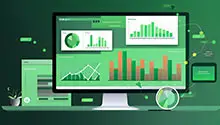When were you first introduced to the terms AI Agents and Agentic AI? Most likely, it was last year. The two terms might seem interchangeable, but they’re quite different.

AI Agents are good for handling specific tasks. They follow rules, use tools, and apply reasoning to get things done. On the other hand, Agentic AI has multiple agents working together autonomously, adapting to challenges, and tackling much more complex tasks. In this blog, I’ll break down the differences, use cases, and challenges based on this research paper.
Table of contents
What are AI Agents?
AI Agents are computer assistants that are meant to perform specific tasks. They are based on large language models (LLMs) or vision models. They operate based on a given set of instructions and sometimes require external tools. But they usually work within a limited boundary. They’re not designed for tackling wide problems but are great at repetitive, goal-oriented tasks such as filtering emails, summarizing reports, or retrieving data.

Read our article on different types of AI Agents to learn more about this concept.
Why Move from Agents to Agentic AI?
AI Agents work well but have their limitations. They’re fine for answering customer questions or doing routine tasks, but they’re not useful when the situation gets complicated. They can’t multitask or accommodate shifting conditions.
This is where Agentic AI comes in.
With several specialized agents acting together, Agentic AI can handle intricate workflows. These agents talk to each other, divide tasks, and make decisions together. And with persistent memory, they can learn and make better decisions over time. Coordination between agents makes things go smoothly, even when they encounter surprise obstacles.

Also Read:
Example of AI Agent vs Agentic AI
Let’s take a simple example. Consider a smart thermostat as an AI Agent. According to your preferences, it maintains the room temperature perfect. As time passes, it understands your routine and assists in saving energy. But it does not integrate with other devices or change according to factors such as weather or energy prices. Even though it does its job perfectly, it does it independently.
How can Agentic AI address this issue?
Agentic AI can be like a whole smart home ecosystem. Multiple agents (weather forecasters, energy managers, security monitors) work together. A weather agent detects a heatwave and informs the energy agent to pre-cool the house. Meanwhile, a security agent activates the surveillance cameras when you’re not home. These agents interact with each other in real time, ensuring your home is comfortable, safe, and energy-efficient.
Much more powerful, right?

Must Read: How to Become an Agentic AI Expert in 2025?
AI Agent vs Agentic AI
Now, let’s dive into the specifics of how these two terms differ across various factors like function, architecture, and coordination. We’ll also look at their respective strengths and challenges. Here’s a breakdown:
- Scope and Complexity: AI Agents are great for specific, defined tasks, but Agentic AI handles more complex, multi-faceted goals.
- Core Purpose: AI Agents have a single task to perform, whereas Agentic AI streamlines complicated processes with several agents cooperating.
- Components of Architecture: AI Agents are founded on LLMs, whereas Agentic AI has several LLMs and typically incorporates different systems. It also entails several agents cooperating with each other, whereas AI Agents usually operate independently.
- Operational Process: AI Agents operate by invoking tools for task execution, whereas Agentic AI uses inter-agent interaction and coordination over multiple steps.
Taxonomy Summary of AI Agent Paradigms
| Conceptual Dimension | AI Agent | Agentic AI |
|---|---|---|
| Initiation Type | Prompt or goal-triggered with tool use | Goal-initiated or orchestrated task |
| Goal Flexibility | (Low) executes specific goal | (High) decomposes and adapts goals |
| Temporal Continuity | Short-term continuity within task | Persistent across workflow stages |
| Learning/Adaptation | (Might in future) Tool selection strategies may evolve | (Yes) Learns from outcomes |
| Memory Use | Optional memory or tool cache | Shared episodic/task memory |
| Coordination Strategy | Isolated task execution | Hierarchical or decentralized coordination |
| System Role | Tool-using task executor | Collaborative workflow orchestrator |
Core Function and Goal
| Feature | AI Agent | Agentic AI |
|---|---|---|
| Primary Goal | Execute a specific task using external tools | Automate complex workflow or achieve high-level goals |
| Core Function | Task execution with external interaction | Workflow orchestration and goal achievement |
Architectural Components
| Component | AI Agent | Agentic AI |
|---|---|---|
| Core Engine | LLM | Multiple LLMs (potentially diverse) |
| Prompts | Yes (task guidance) | Yes (system goal and agent tasks) |
| Tools/APIs | Yes (essential) | Yes (available to constituent agents) |
| Multiple Agents | No | Yes (essential; collaborative) |
| Orchestration | No | Yes (implicit or explicit) |
Operational Mechanism
| Mechanism | AI Agent | Agentic AI |
|---|---|---|
| Primary Driver | Tool calling for task execution | Inter-agent communication and collaboration |
| Interaction Mode | User → Agent → Tool | User → System → Agents |
| Workflow Handling | Single task execution | Multi-step workflow coordination |
| Information Flow | Input → Tool → Output | Input → Agent1 → Agent2 → … → Output |
Scope and Complexity
| Aspect | AI Agent | Agentic AI |
|---|---|---|
| Task Scope | Single, specific, defined task | Complex, multi-faceted goal or workflow |
| Complexity | Medium (integrates tools) | High (multi-agent coordination) |
| Example (Video) | Tavily Search Agent | YouTube-to-Blog Conversion System |
Interaction and Autonomy
| Feature | AI Agent | Agentic AI |
|---|---|---|
| Autonomy Level | Medium (uses tools autonomously) | High (manages entire process) |
| External Interaction | Via specific tools or APIs | Through multiple agents/tools |
| Internal Interaction | N/A | High (inter-agent) |
| Decision Making | Tool usage decisions | Goal decomposition and assignment |
AI Agent Application
Let’s look at a few usecases of AI agents:
Automation of Customer Support

AI agents are simplifying customer support and internal search. For support, they respond to questions such as “Where is my order? ” by extracting information from company systems and responding in seconds. They can also monitor orders or initiate returns. Within the organization, workers leverage the same AI to locate such things as meeting minutes or policy changes. Just ask a question, and it provides a concise, direct answer with citations. It saves time, decreases support requests, and enables teams to work more quickly and intelligently.
Personalized Content Recommendation

AI agents assist in making content personal and accessible. On sites such as Amazon or Spotify, they discover what people like by observing clicks, searches, and purchases. From this, they suggest products, videos, or songs that are similar to your interests—such as recommending gardening books after purchasing tools. In businesses, AI agents in products such as Power BI Copilot enable anyone to pose questions such as “Compare Q3 and Q4 sales” in natural language. The AI then converts that into a chart or report without the assistance of a data analyst. This increases engagement for the users and speeds up and simplifies data reporting for teams.
Applications of Agentic AI
Let us consider a few usecases of Agentic AI:
Collaborative Medical Decision Support

In hospitals, various agents perform various tasks: one reviews patient history, one watches vitals, and a third recommends treatment. They collaborate, exchanging information and ensuring the advice is reliable and consistent. For instance, in an ICU, one agent recognizes early indications of sepsis, one gets recent surgeries, and one offers recommendations based on medical guidelines. Physicians review and validate the final plan. This collaboration lightens the load on physicians, accelerates decision-making, and enhances patient care in risky settings such as ICUs and cancer units.
Intelligent Robotics Coordination

In orchards or warehouses, various robots play various roles, some harvest fruits, others create maps or transport loads. A master AI, referred to as an orchestrator, ensures they seamlessly collaborate. For instance, in an apple farm, drones survey trees and locate ripe fruit. Picker robots are dispatched to the optimum locations, and transport bots shuttle crates around according to real-time requirements. When one robot fails, others compensate automatically. This arrangement enhances productivity, reduces labor expenses, and responds to unexpected shifts more effectively than traditional fixed-program robots.
Limitations AI Agents
Though AI Agents are productive, they have some important limitations:

- Short-Term Focus: AI Agents are poor at long-term planning and flexibility, and thus are not well-suited for activities needing frequent adjustments.
- Causal Misunderstanding: They tend to confuse correlation with causation, which can generate misleading conclusion.
- Inherited Constraints from LLMs: Because AI Agents rely on LLMs, they risk inheriting biases, being input-data-sensitive, and bearing high operational expenses.
Limitations of Agentic AI
Agentic AI, though more capable, isn’t without challenges of its own:

- Increased Complexity: Since there are several agents acting simultaneously, causes become harder to identify and predict outcomes.
- Coordination Issues: The interaction between agents can at times lead to delays or errors.
- Scalability: As Agentic AI systems increase, they become more difficult to scale and debug, with problems that are difficult to fix.
- Security and Ethics: The more agents there are, the higher the risk for security violations and ethical issues. Keeping these systems in line with appropriate regulations grows more difficult as they scale.
- Emergent Behavior: As agents communicate more frequently, their behavior becomes more random, making it more difficult to contain or forecast outcomes.
Want to explore a career in Agentic AI? Checkout our exclusive Agentic AI Pioneer Program!
Conclusion
AI Agents and Agentic AI are both powerful tools, but they serve different purposes. AI Agents are perfect for single, well-defined tasks, while Agentic AI takes things to the next level, managing complex workflows with multiple agents. However, both face challenges, especially when it comes to coordination and scalability. By understanding these differences, we can apply the right tool for the job as these technologies continue to evolve.
So next time someone mixes them up, you’ll know how to set it straight!
All the images and tables used in the article are taken from this research paper.





